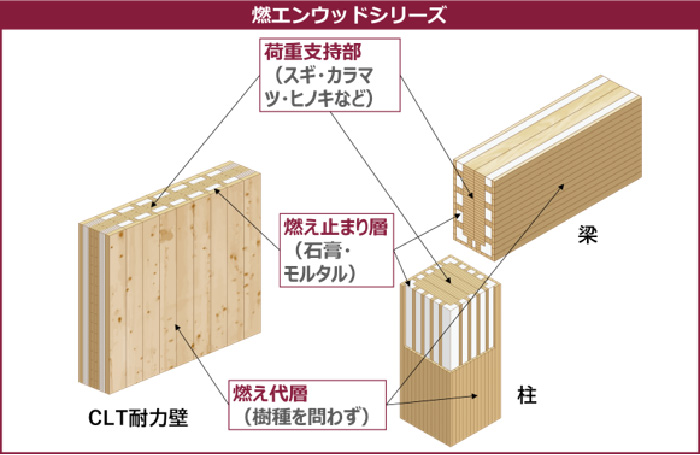
The manmade forests planted shortly after the Second World War have attained an age suitable for felling. This has ushered in a period of authorized utilization of Japan’s forests. However, there are various social problems that have a bearing on the forests of Japan, e.g., fewer individuals engaged in forestry and the stagnation in the demand for domestic lumber.
Under these circumstances, Takenaka Corporation has been promoting the economic utilization of Japan’s forest resources through technological innovation, the use of wood in projects, and advancement of city planning. It can result in a regional revitalization by solving problems related to Japan’s forests.
These efforts play a role in the use of domestic lumber and the introduction of wood-based main structures and wood interiors to public buildings promoted by the government. In addition, these contribute to the promotion of SDGs .
-

Osaka Timber Association Building
(Completed in 2013; constructed using 1 h fire-resistant Moen-Wood) -

PARK WOOD TAKAMORI
(Completed in 2019; constructed using 2 h fire-resistant Moen-Wood) -

FLATS WOODS KIBA
(Completed in 2020; constructed using Moen-wood Samurai) -

High-rise wooden model image
(2025 goals)
Fire-resistant Laminated Material Moen-Wood
Buildings in crowded areas need to display good fire-resistance performance. Moen-Wood is a technology that has been certified*1 for fire-resistance by the Minister of Land, Infrastructure, Transport, and Tourism. Its unique fire-resistant structure enables the use of Japanese cedar, Cypress, and larch without the need for covering the surfaces*2. In 2012, the material was conferred with the ninth Eco-Products Award, the Minister's Prize conferred by the Ministry of Agriculture, Forestry, and Fisheries.
- 1 A system where performance is recognized by the Minister of Land, Infrastructure, Transport, and Tourism in conformity with the Building Standards Act through stringent performance verification by third-party organizations.
- 2 The surfaces of wooden beams and columns need not have fire-resistant protective coverings, etc.
Key Awards for Moen-Wood
2012 Eco-Products Award, the Minister’s Prize conferred by the Ministry of Agriculture, Forestry, and Fisheries
2013 The 22nd Annual Grand Prize for the Global Environment Awards, the Minister's Prize the Ministry of Land, Infrastructure, Transport, and Tourism
2013 The 16th Global Warming Prevention Activity Award, the Minister’s Prize conferred by the Ministry for the Environment
2014 The Prize conferred by the Architectural Institute of Japan
How the Fire-resistant Structure Works
When a fire occurs, the columns and beams (load-bearing centers) are protected by the thermal insulation effect of the surface/burning layer and the heat-absorption effect of the burn-stop/self-charring-stop layer.

The spontaneous extinguishment of flame (self-extinguishment) was verified in a fire-resistance test furnace of a third-party organization after heating the material to a maximum temperature of 945 °C for a specified time.

Two hour Fire-resistant Moen-Wood
With the increase in the number of stories of buildings, there is a demand for materials with fire-resistance performance higher than that of the 1 h fire-resistant structure. The 2 h fire-resistant structure addresses this demand. The thickness of its combustion and fire-resistant layers is 105 mm, which is higher than that of the 1 h fire-resistant type (85 mm). In addition, the structural materials used for each part are different. These measures prevent combustion and carbonization from spreading to the load-bearing center in harsh fire environments.

How Moen-Wood SAMURAI works
Moen-Wood SAMURAI is a hybrid material that displays strength and hardness in addition to the conventional fire-resistance performance. This is achieved by embedding reinforcing bars in the load-bearing center of Moen-Wood. The technology enables the construction of large-span architectural spaces, which are difficult to achieve using wood construction.

- SAMURAI is a technology that was developed jointly by Yamasa Mokuzai Co., Ltd. and Kagoshima University
